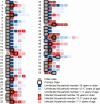High Infection Secondary Attack Rates of Severe Acute Respiratory Syndrome Coronavirus 2 in Dutch Households Revealed by Dense Sampling
- PMID: 33822007
- PMCID: PMC8083540
- DOI: 10.1093/cid/ciab237
High Infection Secondary Attack Rates of Severe Acute Respiratory Syndrome Coronavirus 2 in Dutch Households Revealed by Dense Sampling
Abstract
Background: Indoor environments are considered one of the main settings for transmission of severe acute respiratory syndrome coronavirus 2 (SARS-CoV-2). Households in particular represent a close-contact environment with high probability of transmission between persons of different ages and roles in society.
Methods: Households with a laboratory-confirmed SARS-CoV-2 positive case in the Netherlands (March-May 2020) were included. At least 3 home visits were performed during 4-6 weeks of follow-up, collecting naso- and oropharyngeal swabs, oral fluid, feces and blood samples from all household members for molecular and serological analyses. Symptoms were recorded from 2 weeks before the first visit through to the final visit. Infection secondary attack rates (SAR) were estimated with logistic regression. A transmission model was used to assess household transmission routes.
Results: A total of 55 households with 187 household contacts were included. In 17 households no transmission took place; in 11 households all persons were infected. Estimated infection SARs were high, ranging from 35% (95% confidence interval [CI], 24%-46%) in children to 51% (95% CI, 39%-63%) in adults. Estimated transmission rates in the household were high, with reduced susceptibility of children compared with adolescents and adults (0.67; 95% CI, .40-1.1).
Conclusion: Estimated infection SARs were higher than reported in earlier household studies, presumably owing to our dense sampling protocol. Children were shown to be less susceptible than adults, but the estimated infection SAR in children was still high. Our results reinforce the role of households as one of the main multipliers of SARS-CoV-2 infection in the population.
Keywords: COVID-19; SARS-CoV-2; household study; secondary attack rate; transmission model.
© The Author(s) 2021. Published by Oxford University Press for the Infectious Diseases Society of America.
Figures

References
-
- ProMED International Society for Infectious Diseases. Undiagnosed pneumonia–China (Hubei): request for information. Archive Number: 20191230.6864153. Available at: https://promedmail.org/promed-post/?id=6864153%20#COVID19. Accessed 16 October 2020.
-
- World Health Organization. Timeline of WHO’s response to COVID-19. Available at: https://www.who.int/news/item/29-06-2020-covidtimeline. Accessed 16 October 2020.
MeSH terms
LinkOut - more resources
Full Text Sources
Other Literature Sources
Medical
Miscellaneous

